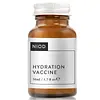What's inside
What's inside
 Key Ingredients
Key Ingredients

 Benefits
Benefits

 Concerns
Concerns

No concerns
 Ingredients Side-by-side
Ingredients Side-by-side

Water
Skin ConditioningNiacinamide
SmoothingPanthenol
Skin ConditioningGlycerin
HumectantCyclodextrin
AbsorbentTriethanolamine
BufferingCarbomer
Emulsion StabilisingPhenoxyethanol
PreservativeButylene Glycol
HumectantParfum
MaskingRetinyl Palmitate
Skin ConditioningArachis Hypogaea Oil
Skin ConditioningEthylhexylglycerin
Skin ConditioningHippophae Rhamnoides Fruit Extract
Skin ConditioningTocopherol
AntioxidantCaprylyl Methicone
Skin ConditioningWater
Skin ConditioningPEG-12 Dimethicone/PPG-20 Crosspolymer
Glycerin
HumectantPropanediol
SolventSodium Polyacrylate
AbsorbentLeontopodium Alpinum Callus Culture Extract
AntioxidantDisodium Acetyl Glucosamine Phosphate
Skin ConditioningProline
Skin ConditioningAlanine
MaskingSerine
MaskingGlucose
HumectantXylitol
HumectantXylitylglucoside
HumectantAnhydroxylitol
HumectantAdansonia Digitata Fruit Extract
EmollientPolypodium Vulgare Rhizome Extract
HumectantCetraria Islandica Thallus Extract
HumectantSphagnum Magellanicum Extract
Skin ConditioningPseudoalteromonas Ferment Extract
HumectantTocopherol
AntioxidantTocopheryl Acetate
AntioxidantMangifera Indica Seed Butter
Skin ConditioningOrbignya Oleifera Seed Oil
EmollientSqualane
EmollientLecithin
EmollientPhenethyl Disiloxane
Skin ConditioningTrimethylsiloxysilicate
EmollientCyclopentasiloxane
EmollientDimethicone
EmollientPolysilicone-11
Dimethicone/Vinyl Dimethicone Crosspolymer
Skin ConditioningHydroxyethyl Acrylate/Sodium Acryloyldimethyl Taurate Copolymer
Emulsion StabilisingXanthan Gum
EmulsifyingCaprylyl Glycol
EmollientSodium Benzoate
MaskingPotassium Sorbate
PreservativeCitric Acid
BufferingSodium Phosphate
BufferingSodium Hydroxide
BufferingEthylhexylglycerin
Skin ConditioningPhenoxyethanol
PreservativeChlorphenesin
AntimicrobialCaprylyl Methicone, Water, PEG-12 Dimethicone/PPG-20 Crosspolymer, Glycerin, Propanediol, Sodium Polyacrylate, Leontopodium Alpinum Callus Culture Extract, Disodium Acetyl Glucosamine Phosphate, Proline, Alanine, Serine, Glucose, Xylitol, Xylitylglucoside, Anhydroxylitol, Adansonia Digitata Fruit Extract, Polypodium Vulgare Rhizome Extract, Cetraria Islandica Thallus Extract, Sphagnum Magellanicum Extract, Pseudoalteromonas Ferment Extract, Tocopherol, Tocopheryl Acetate, Mangifera Indica Seed Butter, Orbignya Oleifera Seed Oil, Squalane, Lecithin, Phenethyl Disiloxane, Trimethylsiloxysilicate, Cyclopentasiloxane, Dimethicone, Polysilicone-11, Dimethicone/Vinyl Dimethicone Crosspolymer, Hydroxyethyl Acrylate/Sodium Acryloyldimethyl Taurate Copolymer, Xanthan Gum, Caprylyl Glycol, Sodium Benzoate, Potassium Sorbate, Citric Acid, Sodium Phosphate, Sodium Hydroxide, Ethylhexylglycerin, Phenoxyethanol, Chlorphenesin
Ingredients Explained
These ingredients are found in both products.
Ingredients higher up in an ingredient list are typically present in a larger amount.
Ethylhexylglycerin (we can't pronounce this either) is commonly used as a preservative and skin softener. It is derived from glyceryl.
You might see Ethylhexylglycerin often paired with other preservatives such as phenoxyethanol. Ethylhexylglycerin has been found to increase the effectiveness of these other preservatives.
Glycerin is already naturally found in your skin. It helps moisturize and protect your skin.
A study from 2016 found glycerin to be more effective as a humectant than AHAs and hyaluronic acid.
As a humectant, it helps the skin stay hydrated by pulling moisture to your skin. The low molecular weight of glycerin allows it to pull moisture into the deeper layers of your skin.
Hydrated skin improves your skin barrier; Your skin barrier helps protect against irritants and bacteria.
Glycerin has also been found to have antimicrobial and antiviral properties. Due to these properties, glycerin is often used in wound and burn treatments.
In cosmetics, glycerin is usually derived from plants such as soybean or palm. However, it can also be sourced from animals, such as tallow or animal fat.
This ingredient is organic, colorless, odorless, and non-toxic.
Glycerin is the name for this ingredient in American English. British English uses Glycerol/Glycerine.
Learn more about GlycerinPhenoxyethanol is a preservative that has germicide, antimicrobial, and aromatic properties. Studies show that phenoxyethanol can prevent microbial growth. By itself, it has a scent that is similar to that of a rose.
It's often used in formulations along with Caprylyl Glycol to preserve the shelf life of products.
Tocopherol (also known as Vitamin E) is a common antioxidant used to help protect the skin from free-radicals and strengthen the skin barrier. It's also fat soluble - this means our skin is great at absorbing it.
Vitamin E also helps keep your natural skin lipids healthy. Your lipid skin barrier naturally consists of lipids, ceramides, and fatty acids. Vitamin E offers extra protection for your skin’s lipid barrier, keeping your skin healthy and nourished.
Another benefit is a bit of UV protection. Vitamin E helps reduce the damage caused by UVB rays. (It should not replace your sunscreen). Combining it with Vitamin C can decrease sunburned cells and hyperpigmentation after UV exposure.
You might have noticed Vitamin E + C often paired together. This is because it is great at stabilizing Vitamin C. Using the two together helps increase the effectiveness of both ingredients.
There are often claims that Vitamin E can reduce/prevent scarring, but these claims haven't been confirmed by scientific research.
Learn more about TocopherolWater. It's the most common cosmetic ingredient of all. You'll usually see it at the top of ingredient lists, meaning that it makes up the largest part of the product.
So why is it so popular? Water most often acts as a solvent - this means that it helps dissolve other ingredients into the formulation.
You'll also recognize water as that liquid we all need to stay alive. If you see this, drink a glass of water. Stay hydrated!
Learn more about Water